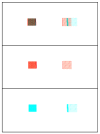Stereoscopic Depth Perception and Visuospatial Dysfunction in Alzheimer's Disease
- PMID: 33546119
- PMCID: PMC7913121
- DOI: 10.3390/healthcare9020157
Stereoscopic Depth Perception and Visuospatial Dysfunction in Alzheimer's Disease
Abstract
With visuospatial dysfunction emerging as a potential marker that can detect Alzheimer's disease (AD) even in its earliest stages and with disturbance in stereopsis suspected to be the prime contributor to visuospatial deficits in AD, we assessed stereoscopic abilities of patients with AD and mild cognitive impairment (MCI). Whereas previous research assessing patients' stereoacuity has yielded mixed results, we assessed patients' capacity to process coarse disparities that can convey adequate depth information about objects in the environment. We produced two virtual cubes at two different distances from the observer by manipulating disparity type (absolute vs. relative), disparity direction (crossed vs. uncrossed) and disparity magnitude, then had participants judge the object that appeared closer to them. Two patient groups performed as well as, or even better than elderly controls, suggesting that AD patients' coarse disparity processing capacity is capable of supporting common tasks involving reaching, grasping, driving, and navigation. Results may help researchers narrow down the exact cause(s) of visuospatial deficits in AD and develop and validate measures to assess visuospatial dysfunction in clinical trials and disease diagnosis.
Keywords: Alzheimer’s disease (AD); binocular disparity; biomarker; coarse disparity; middle temporal area (MT); mild cognitive impairment (MCI); preclinical AD; stereopsis; visuospatial dysfunction.
Conflict of interest statement
The authors declare no conflict of interest.
Figures


References
Grants and funding
LinkOut - more resources
Full Text Sources
Other Literature Sources

